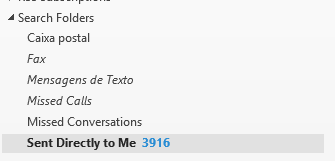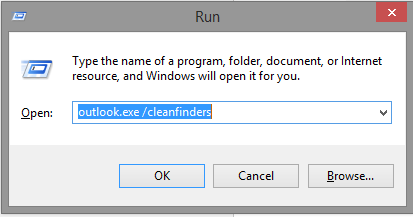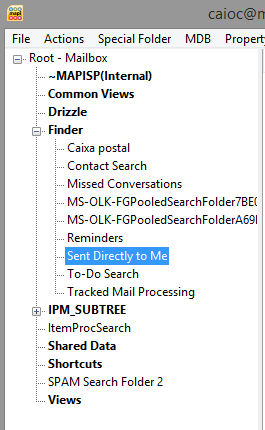O365 – Error when trying to move a mailbox to the cloud “CreatingFolderHierarchy CommunicationErrorTransientException”
By: Caio Ribeiro César
When dealing with moving mailboxes to the cloud, we should remember that there are several steps involved in order to make it work. Troubleshooting online mailbox moves can simple as increasing your upload rate or somewhat complex as the example in this article.
At first, we need to understand what technology is being used for the mailbox move. In this example, we are dealing with a hybrid mailbox move (or rich mailbox move), but there are other migration methods that can be used – for a complete list, please refer to this link.
Since we are dealing with a hybrid mailbox migration, let`s list some of the components that might bring issues while doing the move:
- Exchange On-Premises Performance;
- Exchange On-Premises Components (Mailbox Replication Service, MRSProxy);
- Mailbox Permission;
- Organization Relationship issues;
- Specific steps of the migration and other.
In summary, the rich mailbox move procedure consists of 9 steps:
1. Starting the process (command New-RemoteMoverequest is run by the admin, received by O365 MRS);
2. Validation – Mailbox Replication Service will confirm that the MSExchMailboxGuid from the mailbox is valid;
3. Creation of the mailbox in the store - that will be migrated in the cloud environment;
4. MRS (O365) connects to the local environment in order to find the source mailbox (again, using the property of MsExchMailboxGuid);
5. On-premises MRS finds the source mailbox and sends the information to MRSProxy;
6. MRS service from the cloud opens an WebServices connection with the on-premises CAS server;
7. Data migration starts;
8. When the data migration ends, the source mailbox (on-premises) is converted to a remote mailbox (or mail enabled user “MEU”) and a TargetAddress is added with the onmicrosoft address;
9. The MEU from the cloud is converted to mailbox.
What is a “MEU”? When dealing with hybrid environments, we can`t have two mailboxes for a single user. The object has a single attribute of MSExchMailboxGuid so it can be matched in both environments, it is a mailbox in one of the environments and consequently a MEU in the other.
MEU is an object without attribute values for HomeMDB/homeMTA/msExchHomeServerName, but with an SMTP address configured in TargetAddress pointing to the destination mailbox.
Now that we are aware of some of the steps of the rich mailbox migration, let`s focus on the issue.
When trying to rich-move a specific mailbox to the cloud, the move request would stop in 10% with the error message:
3/4/2014 2:56:14 PM [BLUPR05MB258] The Microsoft Exchange Mailbox Replication service 'BLUPR05MB258.namprd05.prod.outlook.com' (15.0.888.6 caps:0FFF) is examining the request.
3/4/2014 2:56:20 PM [BLUPR05MB258] Connected to target mailbox caioc.onmicrosoft.com\9eb4312d-de3d-4184-a94-db6a2e54120b (Primary)', database 'CA-MDB', Mailbox server 'CASCAIOC.COM' Version 14.3 (Build 123.0), proxy server 'CASCAIOC.COM' 14.3.151.0 caps:05FFFF.
3/4/2014 2:56:21 PM [BLUPR05MB258] Connected to source mailbox 'caiocsource.onmicrosoft.com\9eb4312d-de3d-4184-a924-db6a2e54120b (Primary)', database 'NAMPR05DG017-db022', Mailbox server 'BLUPR05MB258.namprd05.prod.outlook.com' Version 15.0 (Build 888.0).
3/4/2014 2:56:22 PM [BLUPR05MB258] Request processing continued, stage CreatingFolderHierarchy.
3/4/2014 2:56:22 PM [BLUPR05MB258] Initializing folder hierarchy from mailbox 'caioc.onmicrosoft.com\9eb4312d-de3d-4184-a924-db6a2e54120b (Primary)': 207 folders total.
3/4/2014 2:56:22 PM [BLUPR05MB258] Folder creation progress: 0 folders created in mailbox 'caioc.onmicrosoft.com\9eb4312d-de3d-4184-a924-db6a2e54120b (Primary)'.
3/4/2014 2:59:19 PM [BLUPR05MB258] Transient error CommunicationErrorTransientException has occurred. The system will retry (1/60).
In this error message we can understand that:
- The request stops in the creation of the folder hierarchy “CreatingFolderHierarchy”;
- The mailbox being migrated contains 207 folders, but the process fails before the data migration starts and nothing is migrated to the cloud;
- The error message is “CommunicationErrorTransientException”.
We need more information about what exactly is causing this failure so then we can create a solid Action Plan.
We need a verbose report of the move request and then filter it with error messages only. The command below will generate an xml report with debugging information of the move request:
Get-MoveRequestStatistics caioc -IncludeReport | Export-Clixml caioc.xml
This xml needs to be filtered with error messages only. We can create a filter of report failures:
$stats = Import-CliXml caioc.xml
$stats.report.failures[-1]
Result:
Timestamp : 3/4/2014 7:04:16 PM
FailureType : CommunicationErrorTransientException
FailureCode : -2146233088
MapiLowLevelError : 0
FailureSide : Target
FailureSideInt : 2
ExceptionTypes : {Exchange, Transient, MRS, MRSTransient}
ExceptionTypesInt : {1, 2, 10, 11}
Message: The call to 'https://cascaioc.domain.com/EWS/mrsproxy.svc CASCAIOC.com (14.3.151.0 caps:05FFFF)' failed. Error details: The server was unable to process the request due to an internal error. For more information about the error, either turn on IncludeExceptionDetailInFaults (either from ServiceBehaviorAttribute or from the <serviceDebug> configuration behavior) on the server in order to send the exception information back to the client, or turn on tracing as per the Microsoft .NET Framework 3.0 SDK documentation and inspect the server trace logs.. --> The server was unable to process the request due to an internal error. For more information about the error, either turn on IncludeExceptionDetailInFaults (either from ServiceBehaviorAttribute or from the <serviceDebug> configuration behavior) on the server in order to send the exception information back to the client, or turn on tracing as per the Microsoft .NET Framework 3.0 SDK documentation and inspect the server trace logs.
MessageData :
DataContext : --------
Operation: IDestinationFolder.SetSearchCriteria
Operation: IDestinationFolder.SetSearchCriteria
OperationSide: Target
caioc.onmicrosoft.com\9eb4312d-de3d-4184-a924-db6a2e54120b (Primary)
Restriction: Restriction: AND[count:2, AND[count:7, NOT[CONTENT[ptag:0x1a001f(MessageClass), Prefix, IgnoreCase, val:[Tag:0x1a001f(MessageClass),Value:"IPM.Appointment"(string)]]]; NOT[CONTENT[ptag:0x1a001f(MessageClass), Prefix, IgnoreCase, val:[Tag:0x1a001f(MessageClass), Value:"IPM.Contact"(string)]]]; NOT[CONTENT[ptag:0x1a001f(MessageClass), Prefix, IgnoreCase, val:[Tag:0x1a001f(MessageClass),Value:"IPM.DistList"(string)]]];NOT[CONTENT[ptag:0x1a001f(MessageClass), Prefix, IgnoreCase, val:[Tag:0x1a001f(MessageClass), Value:"IPM.Activity"(string)]]]; NOT[CONTENT[ptag:0x1a001f(MessageClass), Prefix, IgnoreCase, val:[Tag:0x1a001f(MessageClass), Value:"IPM.StickyNote"(string)]]]; NOT[CONTENT[ptag:0x1a001f(MessageClass), IgnoreCase, val:[Tag:0x1a001f(MessageClass), Value:"IPM.Task"(string)]]]; NOT[CONTENT[ptag:0x1a001f(MessageClass), Prefix, IgnoreCase, val:[Tag:0x1a001f(MessageClass), Value:"IPM.Task."(string)]]]]; AND[count:2, AND[count:4, PROPERTY[ptag:0xe090102(ParentEntryId), NotEqual, val:[Tag:0xe090102(ParentEntryId), Value:cb = 46, lpb = 00000000297ED05D0A0CD211921C006097D538A20100BC42FDA7843F4947929EED9833A2252700000A6BE4BC0000]]; PROPERTY[ptag:0xe090102(ParentEntryId), NotEqual,
val:[Tag:0xe090102(ParentEntryId), Value:cb = 46, lpb = 00000000297ED05D0A0CD211921C006097D538A20100BC42FDA7843F4947929EED9833A2252700000A6BE4BD0000]]; PROPERTY[ptag:0xe090102(ParentEntryId), NotEqual, val:[Tag:0xe090102(ParentEntryId), Value:cb = 46, lpb 00000000297ED05D0A0CD211921C006097D538A20100BC42FDA7843F4947929EED9833A2252700000A6BE4BE0000]]; PROPERTY[ptag:0xe090102(ParentEntryId), NotEqual, val:[Tag:0xe090102(ParentEntryId), Value:cb = 46, lpb = 00000000297ED05D0A0CD211921C006097D538A20100BC42FDA7843F4947929EED9833A2252700000A6BE4BB0000]]]; AND[count:2, AND[count:2, NOT[OR[count:2, AND[count:3, OR[count:2, NOT[EXIST[ptag:0x10950003]]; PROPERTY[ptag:0x10950003, Equal, val:[Tag:0x10950003, Value:0(int)]]]; EXIST[ptag:0x10900003] PROPERTY[ptag:0x10900003, Equal, val:[Tag:0x10900003, Value:1(int)]]]; AND[count:2, PROPERTY[ptag:0x80920003(NamedProp), Equal, val:[Tag:0x80dd0003(NamedProp), Value:2(int)]]; EXIST[ptag:0x80920003(NamedProp)]]]]; OR[count:3, AND[count:2, EXIST[ptag:0xe2b0003]; BITMASK[ptag:0xe2b0003, NotEqualToZero, mask:0x1]]; AND[count:2, EXIST[ptag:0x10950003] PROPERTY[ptag:0x10950003, GreaterThan, val:[Tag:0x10950003, Value:0(int)]]]; AND[count:2, NOT[AND[count:2, PROPERTY[ptag:0x8093000b(NamedProp), NotEqual, val:[Tag:0x80e4000b(NamedProp), Value:True(bool)]]; PROPERTY[ptag:0x80940003(NamedProp), Equal, val:[Tag:0x80e50003(NamedProp), Value:2(int)]]]]; OR[count:2, CONTENT[ptag:0x1a001f(MessageClass), Prefix, IgnoreCase, val:[Tag:0x1a001f(MessageClass), Value:"IPM.Task."(string)]]; CONTENT[ptag:0x1a001f(MessageClass), IgnoreCase, val:[Tag:0x1a001f(MessageClass), Value:"IPM.Task"(string)]]]]]]; CONTENT[ptag:0x8003101f(NamedProp), IgnoreCase (mv), val:[Tag:0x8002101f(NamedProp), Value:"FII"(string)]]]]] EntryIDs: [count:1, [len=46, data=00000000297ED05D0A0CD211921C006097D538A20100007CA93C08CCD1119219006097D538A20000002882E50000]]
Flags: Recursive, NonContentIndexed, FailOnForeignEID
--------
Search folder: '/Finder/Sent directly to me, entryId [len=46, data=00000000297ED05D0A0CD211921C006097D538A20100ACCB14784BE62B4283BA485D3DB115F1000008147CF50000], parentId [len=46, data=00000000297ED05D0A0CD211921C006097D538A20100007CA93C08CCD1119219006097D538A20000002882EC0000]
DataContextData :
StackTrace : at Microsoft.Exchange.MailboxReplicationService.CommonUtils.CallWCFService[ExceptionT](Action serviceCall, String epAddress, Action`1 faultHandler, VersionInformation
serverVersion)
at Microsoft.Exchange.MailboxReplicationService.CommonUtils.CallService(Action serviceCall, String epAddress, VersionInformation serverVersion)
at Microsoft.Exchange.MailboxReplicationService.MailboxReplicationProxyClient.CallServiceWithTimeout(TimeSpan timeout, Action serviceCall) at Microsoft.Exchange.MailboxReplicationService.MailboxReplicationProxyClient.Microsoft.Exchange.MailboxReplicationService.IMailboxReplicationProxyService.IDestinationFolder_Se tSearchCriteria(Int64 folderHandle, RestrictionData restriction, Byte[][] entryIDs, Int32 searchFlags)
at Microsoft.Exchange.MailboxReplicationService.RemoteDestinationFolder.Microsoft.Exchange.MailboxReplicationService.IDestinationFolder.SetSearchCriteria(RestrictionData restriction, Byte[][] entryIds, SearchCriteriaFlags flags)
at Microsoft.Exchange.MailboxReplicationService.DestinationFolderWrapper.<>c__DisplayClass28.<Microsoft.Exchange.MailboxReplicationService.IDestinationFolder.SetSearchCriteria> b__27() at Microsoft.Exchange.MailboxReplicationService.ExecutionContext.Execute(Action operation)
at Microsoft.Exchange.MailboxReplicationService.ExecutionContextWrapper.Execute(Action operation, Boolean measure)
at Microsoft.Exchange.MailboxReplicationService.DestinationFolderWrapper.Microsoft.Exchange.MailboxReplicationService.IDestinationFolder.SetSearchCriteria(RestrictionData restriction, Byte[][] entryIds, SearchCriteriaFlags flags)
at Microsoft.Exchange.MailboxReplicationService.CommonUtils.ProcessKnownExceptions(ActionactionDelegate, FailureDelegate failureDelegate) at Microsoft.Exchange.MailboxReplicationService.MailboxCopierBase.CopyFolderProperties(FolderRecWrapper folderRec, ISourceFolder sourceFolder, IDestinationFolder destFolder, FolderRecDataFlags dataToCopy, Boolean& isContentAvailable)
at Microsoft.Exchange.MailboxReplicationService.MoveBaseJob.<>c__DisplayClass3a.<>c__DisplayClass3e.<CreateFolderHierarchy>b__37() at Microsoft.Exchange.MailboxReplicationService.ExecutionContext.Execute(Action operation)
at Microsoft.Exchange.MailboxReplicationService.MoveBaseJob.<>c__DisplayClass3a.<CreateFolderHierarchy>b__36(FolderRecWrapper folderRec, EnumFolderContext context)
at Microsoft.Exchange.MailboxReplicationService.FolderMap.EnumSingleFolder(FolderRecWrapper folderRec, EnumFolderContext ctx, EnumFolderCallback callback, EnumHierarchyFlags flags)
at Microsoft.Exchange.MailboxReplicationService.FolderMap.EnumSingleFolder(FolderRecWrapper folderRec, EnumFolderContext ctx, EnumFolderCallback callback, EnumHierarchyFlags flags)
at Microsoft.Exchange.MailboxReplicationService.FolderMap.EnumSingleFolder(FolderRecWrapper folderRec, EnumFolderContext ctx, EnumFolderCallback callback, EnumHierarchyFlags flags)
at Microsoft.Exchange.MailboxReplicationService.FolderMap.EnumerateSubtree(EnumHierarchyFlags flags, FolderRecWrapper root, EnumFolderCallback callback) at Microsoft.Exchange.MailboxReplicationService.MoveBaseJob.CreateFolderHierarchy()
at Microsoft.Exchange.MailboxReplicationService.CommonUtils.ProcessKnownExceptions(Action actionDelegate, FailureDelegate failureDelegate) InnerException : FaultException: The server was unable to process the request due to an internal error. For more information about the error, either turn on IncludeExceptionDetailInFaults
(either from ServiceBehaviorAttribute or from the <serviceDebug> configuration behavior) on the server in order to send the exception information back to the client, or turn on
tracing as per the Microsoft .NET Framework 3.0 SDK documentation and inspect the server trace logs
In this error message, we can understand that the MRS service can`t copy the Search Folder “Sent directly to me”, when trying to create the content hierarchy.
A Search Folder is a virtual folder that provides a view of all email items that match specific search criteria. For example, the Unread Mail Search Folder enables you to view all unread messages in one folder, even though the messages might be saved in different folders.
When asking the end-user to open his Outlook, we could see the “Sent Directly to Me” search folder listed:
The end user removed the search folder (no email is lost, only the search folder is removed and he can recreate it after the migration). And we could re-run the move request with success.
Another option is to remove all search folders by running the command “outlook.exe /cleanfinders”:
If the folder is not available in Outlook and the cleanfinders option doesn’t` fix the issue, we can use MFCMapi (online mode) to validate search folders permissions.
You can download MFCMAPI and configure the end-user Outlook profile to online. Thereafter, open the tool and select the option “Session” and “Logon and Display Store Table”.
Select then the user profile, the mailbox will appear in the tool. Click on it twice so a new window will open:
On the left side, we can find the specific folder:
When right-clicking the folder, there are two options: remove folder or reset permissions. Both options would resolve the incident.
Comments
- Anonymous
January 05, 2016
very interesting
thanks - Anonymous
January 05, 2016
very interesting
thanks - Anonymous
May 17, 2016
This is very much helpful...!! thank you for sharing it. it resolve my long pending migration issue.- Anonymous
May 19, 2016
Thank you!
- Anonymous
- Anonymous
December 02, 2016
Fantastic Post- Anonymous
December 05, 2016
Thank you!
- Anonymous
- Anonymous
January 13, 2017
Perfect post. Had this problem when migrating some mailboxes from O365 back to on premise. I used EWS editor to remove the search folders. - Anonymous
January 13, 2017
Great post indeed, but I have a question:Although there are some fixes listed here, there's just one catch: none of those work if you have Kiosk licenses, since you can't access those mailboxes by MAPI or EWS (they're not licensed to do that).Oddly enough they DO get those finder folders in their mailbox somehow (although they have no use for them), so the issue does pop up from time to time.After reporting this issue with one mailbox 6 months ago, I found this post, and was finally able to fix it by assgning a test E3 license to the user in question. Upon which MS simply closed my case stating 'it got fixed'.This has been a known issue for over a year, but still no fix from MS's end.Now I get the same problem with 3 users, however I don't have any test licenses anymore. Does anyone know of a way to change these finder folders WITHOUT MAPI or EWS access?- Anonymous
January 14, 2017
Hi John, how are you?You can use EWS editor as well (or there are even some .ps1 [Remove-OwaConfig.ps1] out there that can do the trick for you - afaik support has it). This is weird - as fair as I know there is no way to create search folders in OWA (so did they have Outlook previously?). If you reply to this post with the case number, I can check with the owner what is the behavior (I will not approve the comment, so it doesn't get posted externally). Thanks- Anonymous
January 16, 2017
Hi Caio,Case number is (). These users haven't used Outlook before; we assign a Kiosk licenses whenever a new employee gets provisioned, and move them to on prem when they become a desk worker, so they never get any other license before their mailbox is moved to on prem...Problem mailboxes have in the meantime been moved by starting a trial for Business Essentials and temporarily assigning that license to the user.I've tried using EWS editor, but I couldn't open the mailboxes last week using an admin account (which I'd given the applicationimpersonation role for that purpose), however it looks like that does work now (may be replication lag for the role assignment). So thanks for that tip, I'll try that if I run into the issue again. I would be very interested in that script though, since our license assignment and mailbox moves are fully automated :)- Anonymous
February 08, 2017
For those who still bump into the same problem:It looks like the script provided by support doesn't work, it tries to find & delete UserConfigurationProperties for the user, which doesn't seem to exist on Kiosk users.So the trick is to delete the Finder folders instead, either by using EWSEditor, or using this PowerShell script:#Provide credentials of an account on O365 with ApplicationImpersonation role$cred = Get-Credential#Get E-mail address of the user to process$email = Read-Host#Add EWS DLLAdd-Type -Path 'c:\Program Files*\Microsoft\Exchange\Web Services\2.*\Microsoft.Exchange.WebServices.dll'$EWS = New-Object Microsoft.Exchange.WebServices.Data.ExchangeService('Exchange2013_SP1')$EWS.Credentials = $cred.GetNetworkCredential()$EWS.URL = New-Object System.Uri("https://outlook.office365.com/ews/exchange.asmx") # or use autodiscover, whatever you prefer$EWS.ImpersonatedUserId = New-Object Microsoft.Exchange.WebServices.Data.ImpersonatedUserId('SmtpAddress', $email)$root = New-Object Microsoft.Exchange.WebServices.Data.FolderId('Root', $email)# Find folders starting with OwaFv15 and delete them$fview = New-Object Microsoft.Exchange.WebServices.Data.FolderView(50) -Property @{Traversal="Deep"}$flt = new-object Microsoft.Exchange.WebServices.Data.SearchFilter+ContainsSubstring([microsoft.Exchange.WebServices.Data.FolderSchema]::DisplayName,'OwaFv15')$root.FindFolders($flt,$fview) | % { try { Write-Output "Deleting folder $($.DisplayName)" $.Delete('HardDelete'); } catch { Write-Warning "Failed to delete folder: $_" }}- Anonymous
February 08, 2017
The comment has been removed - Anonymous
September 25, 2017
Thank you for the script! One comment though:> $EWS = New-Object Microsoft.Exchange.WebServices.Data.ExchangeService(‘Exchange2013_SP1’)This doesn't work, I had to use:$ExchangeVersion = [Microsoft.Exchange.WebServices.Data.ExchangeVersion]::Exchange2013_SP1$EWS = New-Object Microsoft.Exchange.WebServices.Data.ExchangeService($ExchangeVersion)- Anonymous
October 09, 2017
Nice catch, tested in my lab too.
- Anonymous
- Anonymous
- Anonymous
- Anonymous
- Anonymous
- Anonymous
February 09, 2017
Thank you. This helped solve a pending migration issue for me as well.- Anonymous
February 14, 2017
thanks!!
- Anonymous



